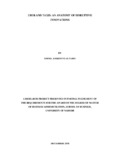| dc.description.abstract | The objective of the study was to establish the effect of Ubers disruptive technologies in Kenya. the study aimed to achieve this by establishing the disruptive innovations caused by Uber, to determine the effect of Uber‟s disruptive innovation in the transport industry and to determine the effect of Uber on technological efficiency of taxi services. This study employed a descriptive research design to gather information relating to the existing status of the phenomena to describe "what exists" pertaining to variables or state of affairs in the situation. The study population consisted of all the Uber drivers in Nairobi. According to Uber Kenya office, as at the end of August 2018, there were 16,897 registered Uber drivers in Kenya. The study used a sample of 51 respondents but achieved a response rate of 82%. Mugenda and Mugenda (2009) indicated that a response percentage of more than 70%, is considered good enough for examination and reporting. The study relied on primary data gathered via a research questionnaire. This study utilized both open ended and close ended questionnaires. Data analyzed via descriptive was presented through mean, standard deviation, graphs, tables and charts. Lastly, it will also use the (Statistical Package for Social Sciences) SPSS software to analyze data as well as make predictions based on data collection. Based on the findings in relation to specific objective, the study concluded that, Uber innovations have caused positive disruptions in Kenyan transport industry by enhancing efficiency, effectiveness cost control, reliability, and customer satisfaction. This study concludes that the changes brought forth by uber innovations are good, competitive, unsustainable and represent the way to the future. Other taxi operators are therefore advised to adapt to technology changes as uber services provide solutions to all previous limitations of ordinary taxis. This study is a relatively new study and there was very limited literature available to guide the researcher on the best methodological and analytical approaches. other limitations included limited time set aside for the research and the limited scope of study. Securing face to face interviews was a challenge due to the senior managers‟ busy schedules and the limited stipulated time to carry out the research. To counter this, appointments were sought and scheduled, sometimes outside the official working hours. | en_US |



